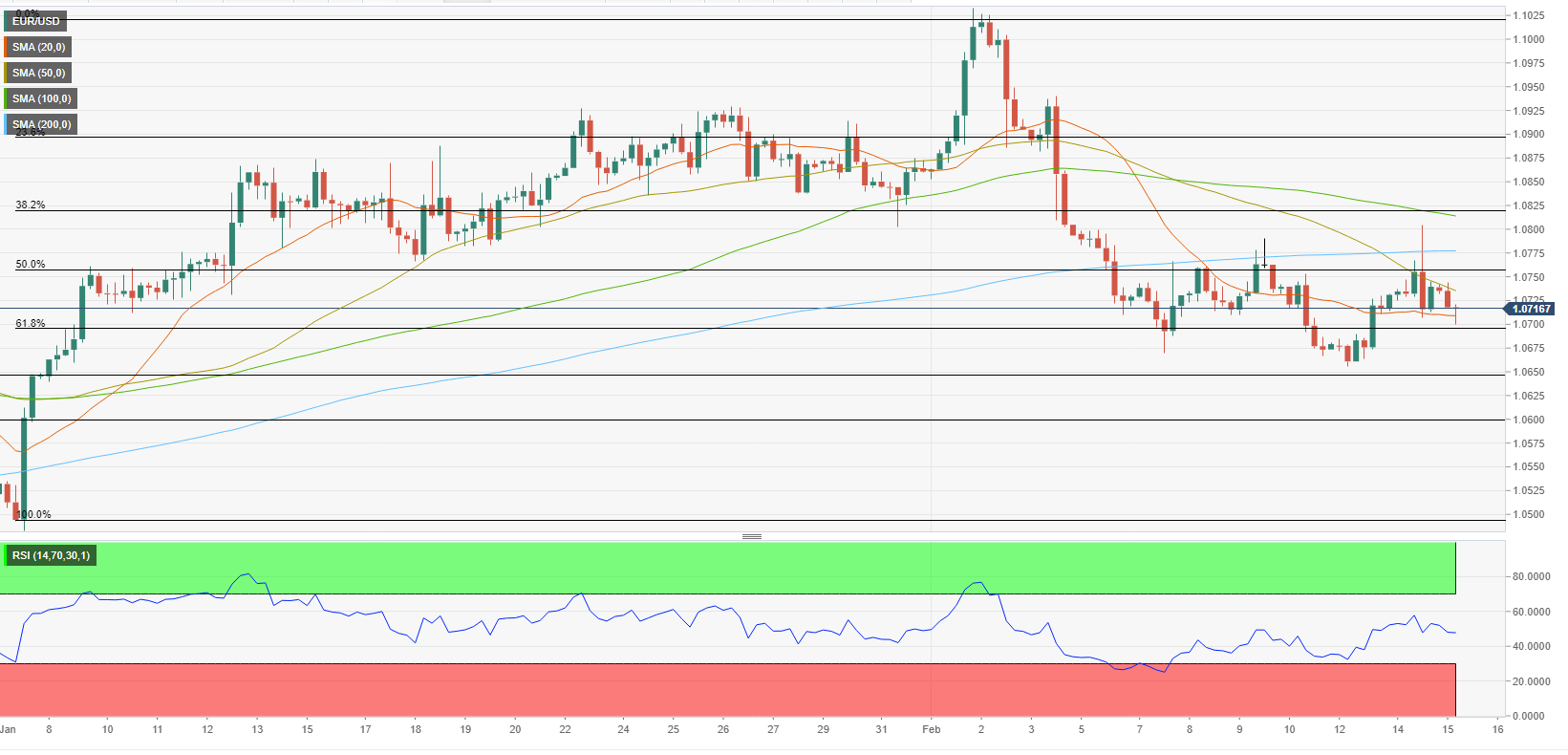- EUR/USD has started to push lower following Tuesday's wild swings.
- 1.0700 aligns as first key support for the pair in the short term.
- EUR/USD is likely to stay on the back foot in case safe-haven flows continue to dominate.
EUR/USD has lost its traction and declined toward 1.0700 mid-week after having spiked to its highest level in two weeks above 1.0800 with the knee-jerk reaction to US inflation data on Tuesday. The pair's near-term technical outlook points to a lack of buyer interest and additional losses could be witnessed in case the market mood fails to improve.
The US Bureau of Labor Statistics reported on Tuesday that the annual Consumer Price Index (CPI) edged lower to 6.4% in January from 6.5% in December. This reading came in slightly higher than the market expectation of 6.2%. On a monthly basis, the Core CPI, which excludes volatile food and energy prices, rose 0.4% as expected. More importantly, the underlying details of the report revealed that the core services' inflation, which the Fed pays close attention to, stood at 7.2% on a yearly basis.
These figures showed markets that the disinflation has not picked up any steam in January and reminded that the Federal Reserve is unlikely to entertain the idea of a policy pivot. According to the CME Group FedWatch Tool, the probability of the US central bank holding the policy rate steady in May following a 25 basis points rate hike in March declined to 16% from 20% ahead of the CPI data release.
Supported by hawkish Fed bets and rising US Treasury bond yields, the US Dollar Index stays in positive territory above 103.50. Meanwhile, US stock index futures are down between 0.4% and 0.7% on the day, reflecting a risk-averse market atmosphere that is beneficial for the US Dollar.
December Industrial Production data will be featured in the European economic docket. Unless this data offers a significant surprise, it is unlikely to trigger a noticeable reaction in the pair. In the second half of the day, January Retail Sales from the US will be looked upon for fresh impetus. Following December's 1.1% contraction, Retail Sales are forecast to rise by 1.8% in January. Although this data should have little to no impact on the Fed's policy outlook, a strong print could help the US Dollar preserve its strength and vice versa.
Market participants will also pay close attention to the performance of Wall Street's main indexes. In case US stocks open deep in negative territory and continue to push lower, EUR/USD could stay under bearish pressure in the second half of the day.
EUR/USD Technical Analysis
EUR/USD failed to hold above the 50-period Simple Moving Average (SMA) on the four-hour chart despite having tested this level several times on Tuesday. Additionally, the Relative Strength Index (RSI) indicator on the same chart retreated below 50, suggesting that buyers remain on the sidelines.
On the downside, 1.0700 (psychological level, Fibonacci 61.8% retracement of the latest uptrend) aligns as key support. A four-hour close below that level could trigger another leg lower toward 1.0645/50 (static level) and 1.0600 (psychological level).
Interim resistance for the pair is located at 1.0730 (50-period SMA) ahead of 1.0760 (Fibonacci 50% retracement). In case the pair rises above the latter resistance, it is likely to face another strong hurdle at 1.0775, where the 200-period SMA is located.
Information on these pages contains forward-looking statements that involve risks and uncertainties. Markets and instruments profiled on this page are for informational purposes only and should not in any way come across as a recommendation to buy or sell in these assets. You should do your own thorough research before making any investment decisions. FXStreet does not in any way guarantee that this information is free from mistakes, errors, or material misstatements. It also does not guarantee that this information is of a timely nature. Investing in Open Markets involves a great deal of risk, including the loss of all or a portion of your investment, as well as emotional distress. All risks, losses and costs associated with investing, including total loss of principal, are your responsibility. The views and opinions expressed in this article are those of the authors and do not necessarily reflect the official policy or position of FXStreet nor its advertisers. The author will not be held responsible for information that is found at the end of links posted on this page.
If not otherwise explicitly mentioned in the body of the article, at the time of writing, the author has no position in any stock mentioned in this article and no business relationship with any company mentioned. The author has not received compensation for writing this article, other than from FXStreet.
FXStreet and the author do not provide personalized recommendations. The author makes no representations as to the accuracy, completeness, or suitability of this information. FXStreet and the author will not be liable for any errors, omissions or any losses, injuries or damages arising from this information and its display or use. Errors and omissions excepted.
The author and FXStreet are not registered investment advisors and nothing in this article is intended to be investment advice.
Recommended Content
Editors’ Picks

GBP/USD stays pressured toward 1.2900 ahead of UK Budget Report
GBP/USD remains under pressured toward 1.2900 in the European session after the UK's ONS reported that the annual CPI inflation softened to 2.8% in February from 3% in January. This reading came in below the market expectation of 2.9%, weighing on the Pound Sterling ahead of the UK Budget Report.

EUR/USD wavers near 1.0800, US data eyed
EUR/USD trades sideway near 1.0800 in Wednesday's European trading hours as the US Dollar struggles amid the latest tariff threats by US President Trump. Dovish ECB commentary limits the pair's upside ahead of US data and Fedspeak.

Gold bid with Copper rising to record high on tariff threat
Gold’s price is heading to $3,020 at the time of writing on Wednesday and has turned this week’s performance positive after its initial move lower on Monday. The precious metal is being bought together with other precious metals as Copper pops to a new all-time high.

Shiba Inu Price Forecast: SHIB rallies as trading volume rises 228% amid increase in bullish bets
Shiba Inu (SHIB) price extends its gains by 8% and trades at $0.000015 at the time of writing on Wednesday, rallying over 15% so far this week.

Seven Fundamentals for the Week: Tariff news, fresh surveys, the Fed's preferred inflation gauge are eyed Premium
Reports and rumors ahead of Trump’s reciprocal tariffs announcement next week will continue moving markets. Business and consumer surveys will try to gauge where the US economy is heading. Core PCE, the Fed's preferred inflation gauge, is eyed late in the week.

The Best brokers to trade EUR/USD
SPONSORED Discover the top brokers for trading EUR/USD in 2025. Our list features brokers with competitive spreads, fast execution, and powerful platforms. Whether you're a beginner or an expert, find the right partner to navigate the dynamic Forex market.
